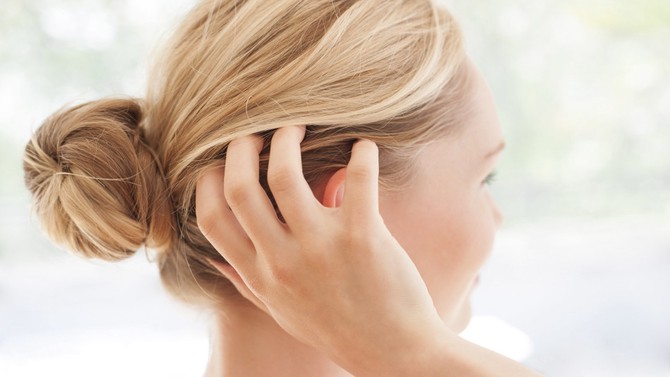8 Reasons Why Your Hair Is Getting Thinner—and How to Fix It
The first step is narrowing in on the cause.
By Emma Haak

Photo: Jacob Ammentorp Lund/iStock
You're Noticing: Thinning Along the Hairline
Likely cause: Regularly yanking your hair back into too-tight styles
Why it leads to thinning: Putting tension on the hairs at the front of your scalp can make them fall out. There's even a name for this type of thinning: traction alopecia. (Going overboard on hair extensions can also cause traction alopecia wherever the extensions are attached, says Doris Day, MD, a clinical associate professor of dermatology at NYU Langone Medical Center, in New York.)
How to fix it: First, be gentler to keep the problem from getting worse. If your go-to style is a ponytail or bun, use your fingertips to feel around your temples and crown and make sure you can move your hair a little. Minoxidil (the only FDA-approved topical treatment to regrow hair) can help fill in the sparse areas.

Photo: PeopleImages/iStock
You're Noticing: Your Part Seems to be Getting Wider
Likely Cause: Female-pattern hair loss due to aging, changing hormone levels (hello, menopause!) or a family history of thinning
Why it leads to thinning: It's not clear why but this type of thinning generally affects the part first and expands from there. Hair follicles start to shrink, producing shorter and finer hairs than they used to before they stop producing hairs at all. It generally doesn't lead to serious balding though.
How to fix it: Minoxidil is your best option. As of 2014, 5-percent-Minoxidil products are available for women in addition to the standard 2 percent (the former used to be approved for use in men only). Your doctor may also recommend laser treatments aimed at stimulating hair growth.

Photo: digitalskillet/iStock
You're Noticing: Diffuse Thinning All Over Your Head
Potential cause: Major stress
Why it leads to thinning: Physiological stress, whether it's from a breakup, the loss of a loved one or a traumatic physical event (childbirth is a classic example), can shift hair follicles into rest mode, where they stop producing hair. It's called telogen effluvium, and it's very common, says Pamela Jakubowicz, MD, a dermatologist at Montefiore Medical Center, in New York. Because of hair's growth cycle, you'll notice thinning roughly 3 months after the stressful event.
How to fix it: Telogen effluvium generally resolves on its own. You should notice improvement about 3 months after stress levels return to normal.
Potential cause: Medications
Why it leads to thinning: Some drugs are known to cause hair thinning. Prime examples: hormonal birth control, isotretinoin for acne, blood pressure medications, cholesterol-lowering drugs and certain antidepressants.
How to fix it: Minoxidil may help, but if your hair loss is affecting your well-being, Sejal Shah, MD, a board certified dermatologist in New York, recommends asking your prescribing doctor if there are other medications you can try that don't have that as a side effect.
Potential cause: Frying your hair with hot tools
Why it leads to thinning: High heat creates air bubbles within the hair shaft that can cause breakage. If tools get too close to the root, they can damage the hair follicle.
How to fix it: Medium heat is best—if your hot tools have an intensity range between 1 and 10, for example, set them at 5. Keep hot styling tools at least an inch or two away from your scalp to protect the follicle.
Potential cause: A thyroid disorder
Why it leads to thinning: Thyroid issues lead to hair loss because follicles can't get resources they need to produce hair, says Jakubowicz. In hypothyroidism, it's because your whole system is moving slower; in hyperthyroidism, it's likely because your body is depleting resources faster.
How to fix it: If your dermatologist suspects a systemic condition like a thyroid problem is causing your thinning, they'll refer you to your internist for testing and treatment, which should also help with the hair loss.

Photo: Ian Hooton/Getty Images
You're Noticing: You're Losing Hair in Patches
Potential cause: Skin conditions like eczema or psoriasis
Why it leads to thinning: Scaliness and buildup of skin cells on the scalp can lead to hair loss, explains Shah. (Scratching to relieve itching can make it worse.) Seborrheic dermatitis, an inflammatory condition that mainly affects the scalp and causes scaly patches, red skin and dandruff, can also trigger hair loss.
How to fix it: Treat the skin issue and hair should start to grow back on its own. Topical steroids, antifungals and medicated shampoos are often the first steps, and your dermatologist may recommend stronger options like phototherapy or oral and injectable medications if you need a more aggressive treatment.
Potential cause: Alopecia areata
Why it leads to thinning: This autoimmune condition is relatively rare, affecting roughly 2 percent of the U.S. population, but it's very noticeable because it starts with quarter-sized patches of hair loss. It often begins in childhood as the immune system attacks hair follicles.
How to fix it: There's no cure or official medications, but your doctor might recommend treatments approved for other hair-loss conditions to try to stimulate growth (cortisone injections are one option, says Day). Your dermatologist will confirm the condition first (often by pulling out a hair or two and examining them under a microscope or doing a skin biopsy of the scalp) and proceed from there.
Published 12/02/2015

